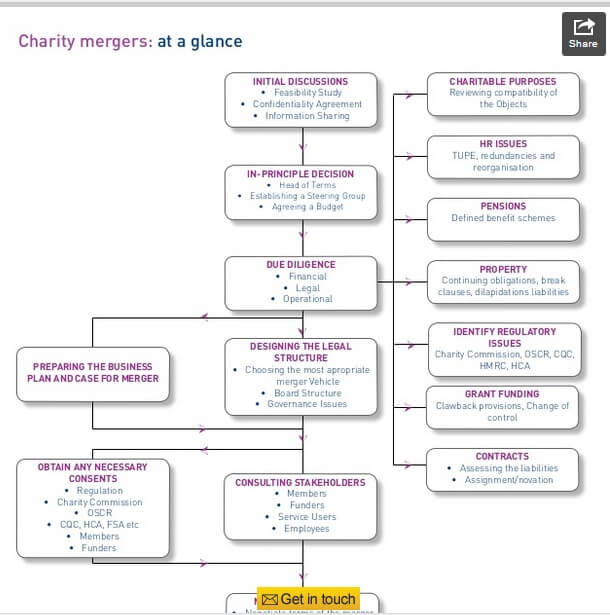How to Merge Charities: The Process and Legal Implications of a Charity Merger
How to Merge Charities: The Process and Legal Implications of a Charity Merger
Over the last 15 years I have been involved in helping charities merge. At the start of my career I was lucky to be involved in the most amazing charity merger which formed Cancer Research UK. And since then I have been involved in tens of mergers of different types of charities in various different sectors.
Charity mergers and acquisitions
Now experience has shown that it is not always an easy journey for charities to merge and early planning and preparation is essential to make sure that you smooth the path as much as you possibly can. You also have to be really clear about why it is important for your charity to merge; what are the reasons for merger. You have to clearly articulate those reasons as you approach various stages.
There are a number of reasons for carrying out a charity merger and there will be a combination of a number of these different reasons which will form part of your case for a merger.
One question to ask is: Why is the merger in the best interests of your charity?
Those reasons include:
1. Increased reach of services – i.e. being able to deliver more for more beneficiaries for more parts of the country.
2. Reduced costs and duplication i.e. being able to take out part of the back office services and deliver more efficiently thereby reducing cost.
3. Increased access to funding. In fact we often find that it is the funders that are driving the merger.
4. Financial uncertainty is often cited as the most common reason for charities to come together. However merging charities in times of financial difficulty can be quite problematic.
5. There are benefits of scale that you may be able to achieve by putting your 2 charities together.
6. An enhanced public profile – i.e. greater voice, either within your area of influence or your local area.
Legal and financial issues associated with charity mergers
In articulating your case for merger, there are a number of key issues that you will need to discuss with your board of charity trustees.
1. Is the charity merger in the best interests of the charity? Will it deliver more for the beneficiaries?
2. Have you chosen the right merger partner? Are your goals and vision compatible?
3. Have stakeholders and beneficiaries been consulted? You need to make sure that you are effectively communicating with these parties and understand the concerns that they may raise.
4. What are the risks attached to the merger? Can you anticipate any issues that will need to be resolved?
5. Have you estimated the full cost of merging? These include staff time, management and professional fees, costs of relocation, integrating systems
7. If you have members – have you established whether consent is required? If you are a membership charity do members have the right to veto the merger. If so, you need to consider how you will obtain content and by-in.
Charity merger steering group
Due to the issues and complexity involved, we recommend that the trustee body sets up a merger steering group. This steering group can either work in tandem with your merging partner or alone; but essentially it is a group of 3-4 trustees with the time and necessary degrees of skills and experience to consider these complex issues.
One of the first tasks that this merger steering group will be charged with is getting on top of the process of due diligence.
Due diligence is a critical part of merger process. It is the process by which you go into the other charity; you make sure that you understand all of their operations and finances and that there are no hidden liabilities that have not been previously revealed to you. It is important that you do this at the outset as there is no coming back on a charity merger.
The process of due diligence will also often be the means and mechanism by which you might identify any potential deal breakers. For example it may be the first time that you are aware of potential pension liabilities or regulatory consents that you might not be able to obtain.
Due diligence can be done both with the support of professional advisors ,or if you have the necessary degree of skills with in your own charity, by the charity in-house themselves. You need to set out a clear process by which the due diligence will be undertaken and also have a mechanism by which your merger steering group is going to report back on the process to your trustee board. And once you have been through the due diligence process, and you have confirmed that there are no deal breakers, you will on your path to merger. You will be at a stage that you will be able to take an in principal decision that, providing everything else falls into line, broadly speaking – you’re at a place where the 2 charities have agreed to merge.
The charity merger process: An overview
 Charity Mergers Process: How To Merge Your Charity Effectively from IBB Charity Merger Lawyers
Charity Mergers Process: How To Merge Your Charity Effectively from IBB Charity Merger Lawyers
Merging charities is not a simple process. Here at IBB Solicitors, we have a team of people with specialist experience and skills who can help guide you through the process. To discuss your charity merger contact IBB’s expert charity solicitors today on 01895 207809 or email charities@ibblaw.co.uk.
